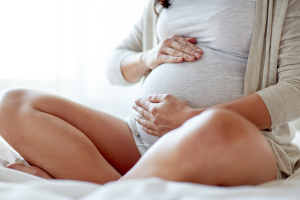
The second trimester of pregnancy, spanning weeks 13 to 27, is often considered the most comfortable phase. For many, the intense fatigue and nausea of the first trimester begin to fade, replaced by a noticeable baby bump and renewed energy. However, this period also brings a variety of physical and emotional changes as the baby grows rapidly and the body adjusts to support development. Understanding what to expect can help you feel more confident and prepared as your pregnancy progresses.
Highlights
• A growing uterus and baby bump become more visible, often relieving early pregnancy discomforts.
• Hormonal changes can lead to skin changes, nasal congestion, and increased hair growth.
• Common discomforts include back pain, round ligament pain, and increased vaginal discharge.
• Emotional well-being may improve, but mood swings and anxiety can still occur.
• Prenatal checkups in this trimester often include anatomy scans and glucose screenings.
Visible Growth and a Shifting Center of Gravity
One of the most noticeable changes during the second trimester is the growth of the uterus, which expands upward and outward to accommodate the baby. This results in a visible baby bump that many expectant parents eagerly anticipate. As your abdomen expands, your posture and balance begin to shift. This may cause changes in how you walk and can contribute to discomfort in your lower back or pelvis. Additionally, weight gain accelerates in this trimester, averaging around 1 pound per week, depending on individual factors and healthcare guidance.
Skin and Hair Changes Due to Hormones
Hormonal changes continue to influence many parts of the body during this time. Increased blood flow and hormone production can lead to the “pregnancy glow,” a healthy, flushed look due to increased oil production and circulation. However, these same changes may also cause acne or sensitivity in some people. A dark line, called the linea nigra, may appear running from the pubic bone to the belly button. You might also notice areas of darkened skin on your face, known as melasma or “the mask of pregnancy.” Hair often becomes thicker and shinier, while nail growth may speed up.
New Aches and Physical Sensations
As the uterus grows and stretches, many people experience round ligament pain—sharp or cramping sensations in the lower abdomen or groin area. Back pain is another common complaint, often related to both weight gain and the loosening of ligaments due to the hormone relaxin. Increased vaginal discharge is also typical in this trimester and helps protect against infections. However, any unusual odor, color, or itching should be brought to your provider’s attention. You may also begin to feel your baby move, often described as flutters or bubbles, which is one of the most exciting milestones of the second trimester.
Shifting Emotions and Mental Health
Many pregnant individuals report improved mood and energy levels during the second trimester. Hormones may stabilize somewhat, allowing for better emotional regulation compared to the first trimester. However, it’s still common to experience mood swings, anxiety, or concerns about the future. This is a good time to explore prenatal classes, seek support groups, or talk with a mental health professional if needed. Bonding with your baby may also begin to deepen as movements are felt and the reality of pregnancy becomes more tangible.
Medical Milestones and Monitoring
Several important prenatal screenings occur during this stage. The mid-pregnancy anatomy ultrasound, typically performed around 18–22 weeks, checks the baby’s organs, limbs, and overall growth. This scan can often determine the baby’s sex, if desired. Many healthcare providers also schedule a glucose screening between weeks 24 and 28 to check for gestational diabetes. As your body changes, your provider may also monitor for early signs of complications like preeclampsia or anemia, and will continue to track your weight, blood pressure, and overall well-being.
The second trimester is often a welcome relief after the challenges of early pregnancy, but it comes with its own set of physical and emotional changes. From skin shifts to ligament pain, every symptom is part of your body’s remarkable effort to nurture new life. Staying informed and attending regular prenatal visits helps ensure a healthy, supported journey through this exciting phase.
Back







